Scope
- Candidate: What features are important? Interviewer: Ability to upload a video and watch a video.
- Candidate: What clients do we need to support? Interviewer: Mobile apps, web browsers, and smart TV.
- Candidate: How many daily active users do we have? Interviewer: 5 million
- Candidate: What is the average daily time spent on the product? Interviewer: 30 minutes.
- Candidate: Do we need to support international users? Interviewer: Yes, a large percentage of users are international users.
- Candidate: What are the supported video resolutions? Interviewer: The system accepts most of the video resolutions and formats.
- Candidate: Is encryption required? Interviewer: Yes
- Candidate: Any file size requirement for videos? Interviewer: Our platform focuses on small and medium-sized videos. The maximum allowed video size is 1GB.
- Candidate: Can we leverage some of the existing cloud infrastructures provided by Amazon, Google, or Microsoft? Interviewer: That is a great question. Building everything from scratch is unrealistic for most companies, it is recommended to leverage some of the existing cloud services.
Envelope Estimation
- Assume the product has 5 million daily active users (DAU).
- Users watch 5 videos per day.
- 10% of users upload 1 video per day.
- Assume the average video size is 300 MB.
- Total daily storage space needed: 5 million * 10% * 300 MB = 150TB
- CDN cost.
- When cloud CDN serves a video, you are charged for data transferred out of the CDN.
- Let us use Amazon’s CDN CloudFront for cost estimation (Figure 14-2) [3]. Assume 100% of traffic is served from the United States. The average cost per GB is $0.02. For simplicity, we only calculate the cost of video streaming.
- 5 million * 5 videos * 0.3GB * $0.02 = $150,000 per day.
High-level Design
My Own Design
Video uploading flow

It consists of the following components:
- User: A user watches YouTube on devices such as a computer, mobile phone, or smart TV.
- Load balancer: A load balancer evenly distributes requests among API servers.
- API servers: All user requests go through API servers except video streaming.
- Metadata DB: Video metadata are stored in Metadata DB. It is sharded and replicated to meet performance and high availability requirements.
- Metadata cache: For better performance, video metadata and user objects are cached.
- Original storage: A blob storage system is used to store original videos. A quotation in Wikipedia regarding blob storage shows that: “A Binary Large Object (BLOB) is a collection of binary data stored as a single entity in a database management system”.
- Transcoding servers: Video transcoding is also called video encoding. It is the process of converting a video format to other formats (MPEG, HLS, etc), which provide the best video streams possible for different devices and bandwidth capabilities.
- Transcoded storage: It is a blob storage that stores transcoded video files.
- CDN: Videos are cached in CDN. When you click the play button, a video is streamed from the CDN.
- Completion queue: It is a message queue that stores information about video transcoding completion events.
- Completion handler: This consists of a list of workers that pull event data from the completion queue and update metadata cache and database.
Now that we understand each component individually, let us examine how the video uploading flow works. The flow is broken down into two processes running in parallel.
- Upload the actual video.
- Update video metadata. Metadata contains information about video URL, size, resolution, format, user info, etc.
Flow a: upload the actual video
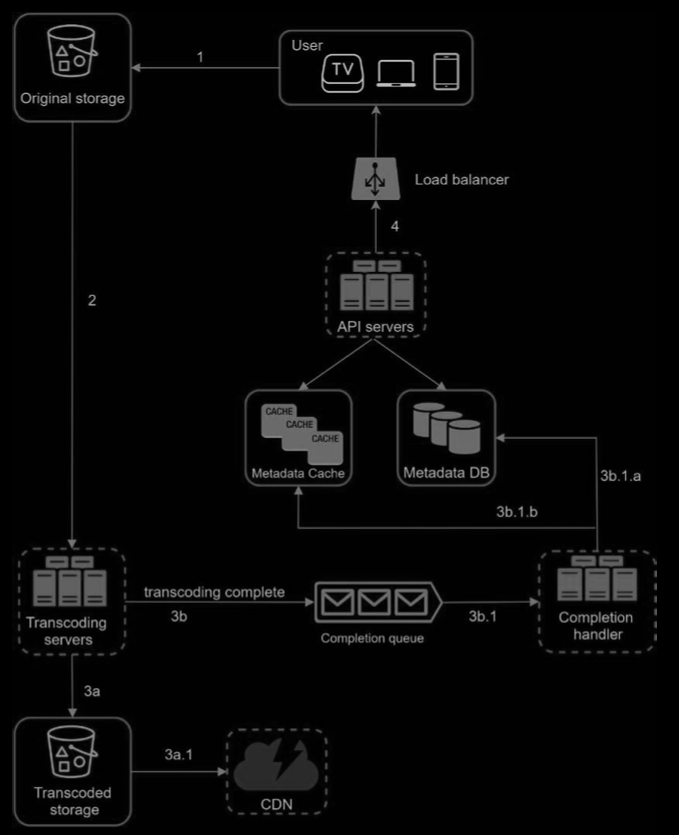
- 1.Videos are uploaded to the original storage.
- 2.Transcoding servers fetch videos from the original storage and start transcoding.
- 3.Once transcoding is complete, the following two steps are executed in parallel:
- 3a. Transcoded videos are sent to transcoded storage.
- 3b. Transcoding completion events are queued in the completion queue.
- 3a.1. Transcoded videos are distributed to CDN.
- 3b.1. Completion handler contains a bunch of workers that continuously pull event data from the queue.
- 3b.1.a. and 3b.1.b. Completion handler updates the metadata database and cache when video transcoding is complete.
- 4.API servers inform the client that the video is successfully uploaded and is ready for streaming.
Flow b: update the metadata
Video streaming flow
Whenever you watch a video on YouTube, it usually starts streaming immediately and you do not wait until the whole video is downloaded. Downloading means the whole video is copied to your device, while streaming means your device continuously receives video streams from remote source videos. When you watch streaming videos, your client loads a little bit of data at a time so you can watch videos immediately and continuously.
Before we discuss video streaming flow, let us look at an important concept: streaming protocol. This is a standardized way to control data transfer for video streaming. Popular streaming protocols are:
- MPEG–DASH. MPEG stands for “Moving Picture Experts Group” and DASH stands for “Dynamic Adaptive Streaming over HTTP”.
- Apple HLS. HLS stands for “HTTP Live Streaming”.
- Microsoft Smooth Streaming.
- Adobe HTTP Dynamic Streaming (HDS).
You do not need to fully understand or even remember those streaming protocol names as they are low-level details that require specific domain knowledge. The important thing here is to understand that different streaming protocols support different video encodings and playback players. When we design a video streaming service, we have to choose the right streaming protocol to support our use cases.
Videos are streamed from CDN directly. The edge server closest to you will deliver the video. Thus, there is very little latency. Figure 14-7 shows a high level of design for video streaming.
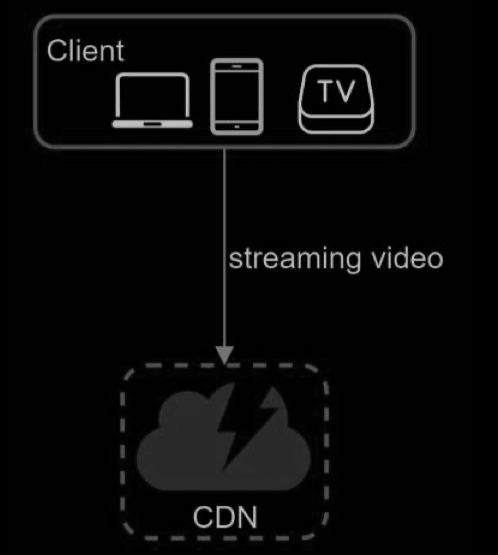
Deep Dive
My Own Design
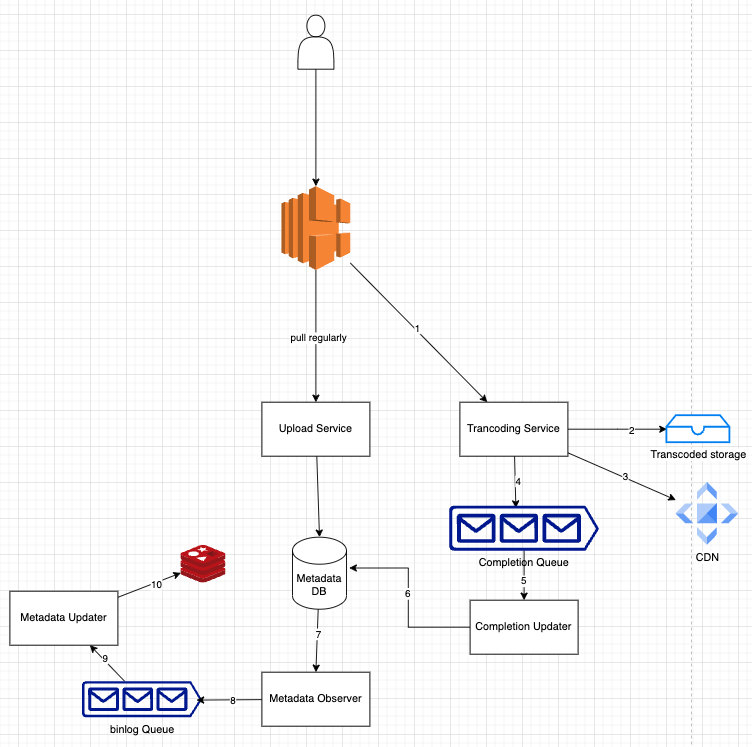
Video transcoding
When you record a video, the device (usually a phone or camera) gives the video file a certain format. If you want the video to be played smoothly on other devices, the video must be encoded into compatible bitrates and formats. Bitrate is the rate at which bits are processed over time. A higher bitrate generally means higher video quality. High bitrate streams need more processing power and fast internet speed.
Many types of encoding formats are available; however, most of them contain two parts:
- Container: This is like a basket that contains the video file, audio, and metadata. You can tell the container format by the file extension, such as .avi, .mov, or .mp4.
- Codecs: These are compression and decompression algorithms aim to reduce the video size while preserving the video quality. The most used video codecs are H.264, VP9, and HEVC
Directed acyclic graph (DAG) model
Transcoding a video is computationally expensive and time-consuming. Besides, different content creators may have different video processing requirements. For instance, some content creators require watermarks on top of their videos, some provide thumbnail images themselves, and some upload high definition videos, whereas others do not.
To support different video processing pipelines and maintain high parallelism, it is important to add some level of abstraction and let client programmers define what tasks to execute. For example, Facebook’s streaming video engine uses a directed acyclic graph (DAG) programming model, which defines tasks in stages so they can be executed sequentially or parallelly. In our design, we adopt a similar DAG model to achieve flexibility and parallelism. The following diagram represents a DAG for video transcoding.
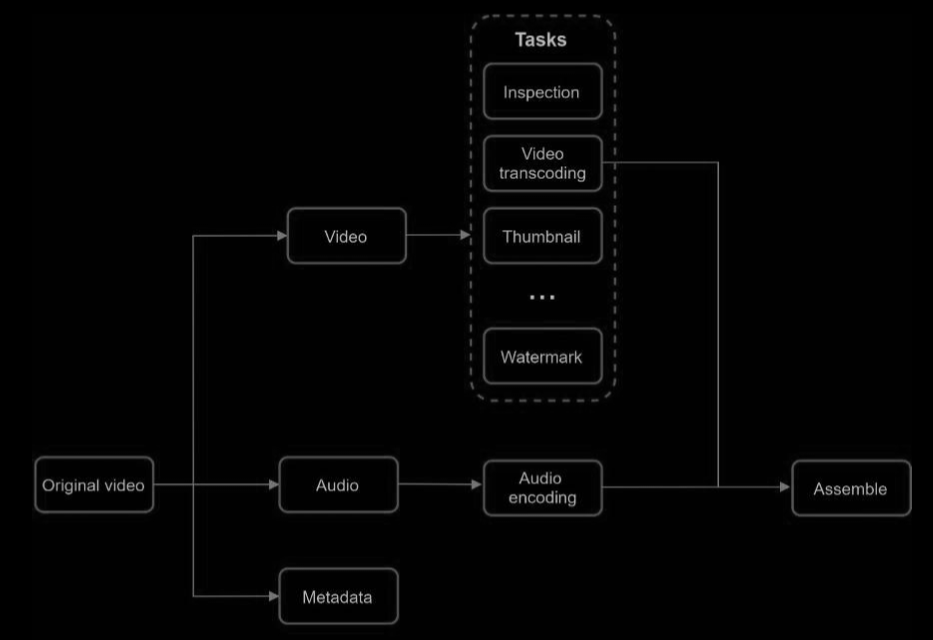
the original video is split into video, audio, and metadata. Here are some of the tasks that can be applied on a video file:
- Inspection: Make sure videos have good quality and are not malformed.
- Video encodings: Videos are converted to support different resolutions, codec, bitrates, etc.
- Thumbnail. Thumbnails can either be uploaded by a user or automatically generated by the system.
- Watermark: An image overlay on top of your video contains identifying information about your video.
Video transcoding architecture
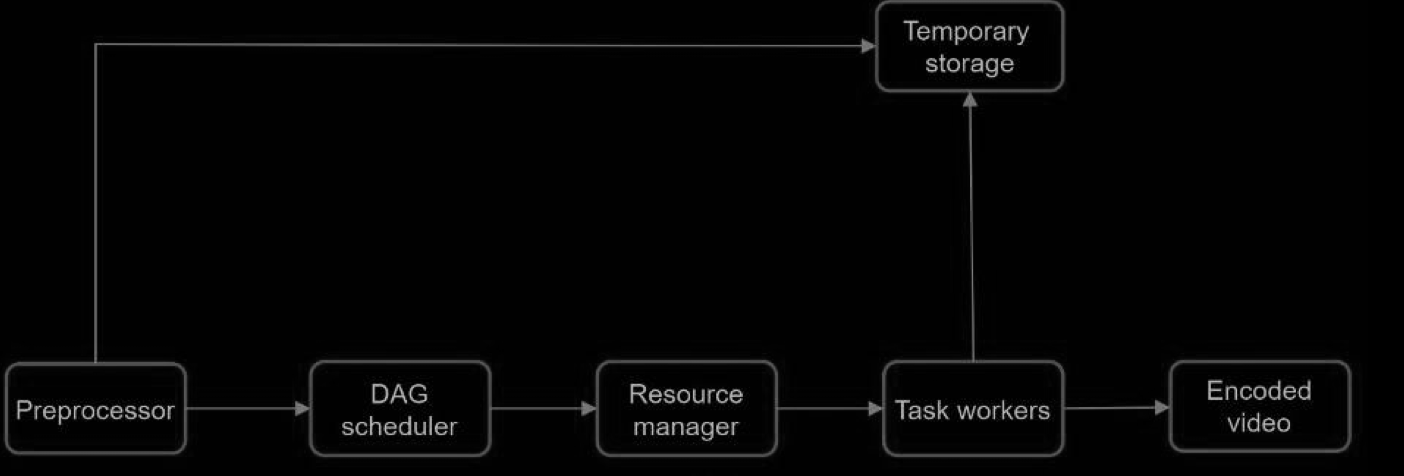
The architecture has six main components: preprocessor, DAG scheduler, resource manager, task workers, temporary storage, and encoded video as the output. Let us take a close look at each component.
Preprocessor
The preprocessor has 4 responsibilities:
-
Video splitting. Video stream is split or further split into smaller Group of Pictures (GOP) alignment. GOP is a group/chunk of frames arranged in a specific order. Each chunk is an independently playable unit, usually a few seconds in length.
-
Some old mobile devices or browsers might not support video splitting. Preprocessor split videos by GOP alignment for old clients.
-
DAG generation. The processor generates DAG based on configuration files client programmers write.
-
Cache data. The preprocessor is a cache for segmented videos. For better reliability, the preprocessor stores GOPs and metadata in temporary storage. If video encoding fails, the system could use persisted data for retry operations.
DAG scheduler
The DAG scheduler splits a DAG graph into stages of tasks and puts them in the task queue in the resource manager.

The original video is split into three stages: Stage 1: video, audio, and metadata. The video file is further split into two tasks in stage 2: video encoding and thumbnail. The audio file requires audio encoding as part of the stage 2 tasks.
Resource manager
The resource manager is responsible for managing the efficiency of resource allocation. It contains 3 queues and a task scheduler as shown below.
- Task queue: It is a priority queue that contains tasks to be executed.
- Worker queue: It is a priority queue that contains worker utilization info.
- Running queue: It contains info about the currently running tasks and workers running the tasks.
- Task scheduler: It picks the optimal task/worker, and instructs the chosen task worker to execute the job.

The resource manager works as follows:
- The task scheduler gets the highest priority task from the task queue.
- The task scheduler gets the optimal task worker to run the task from the worker queue.
- The task scheduler instructs the chosen task worker to run the task.
- The task scheduler binds the task/worker info and puts it in the running queue.
- The task scheduler removes the job from the running queue once the job is don
Task workers
Task workers run the tasks which are defined in the DAG. Different task workers may run different tasks.
Encoded video
Encoded video is the final output of the encoding pipeline. Here is an example of the output: funny_720p.mp4 .
System optimizations
Speed optimization: parallelize video uploading
Uploading a video as a whole unit is inefficient. We can split a video into smaller chunks by GOP alignment.

This allows fast resumable uploads when the previous upload failed. The job of splitting a video file by GOP can be implemented by the client to improve the upload speed as shown below.

Speed optimization: place upload centers close to users
Another way to improve the upload speed is by setting up multiple upload centers across the globe. People in the United States can upload videos to the North America upload center, and people in China can upload videos to the Asian upload center. To achieve this, we use CDN as upload centers.
Speed optimization: parallelism everywhere
Achieving low latency requires serious efforts. Another optimization is to build a loosely coupled system and enable high parallelism.
Our design needs some modifications to achieve high parallelism. Let us zoom in to the flow of how a video is transferred from original storage to the CDN.

To make the system more loosely coupled, we introduced message queues.
Safety optimization: pre-signed upload URL
Safety is one of the most important aspects of any product. To ensure only authorized users upload videos to the right location, we introduce pre-signed URLs.
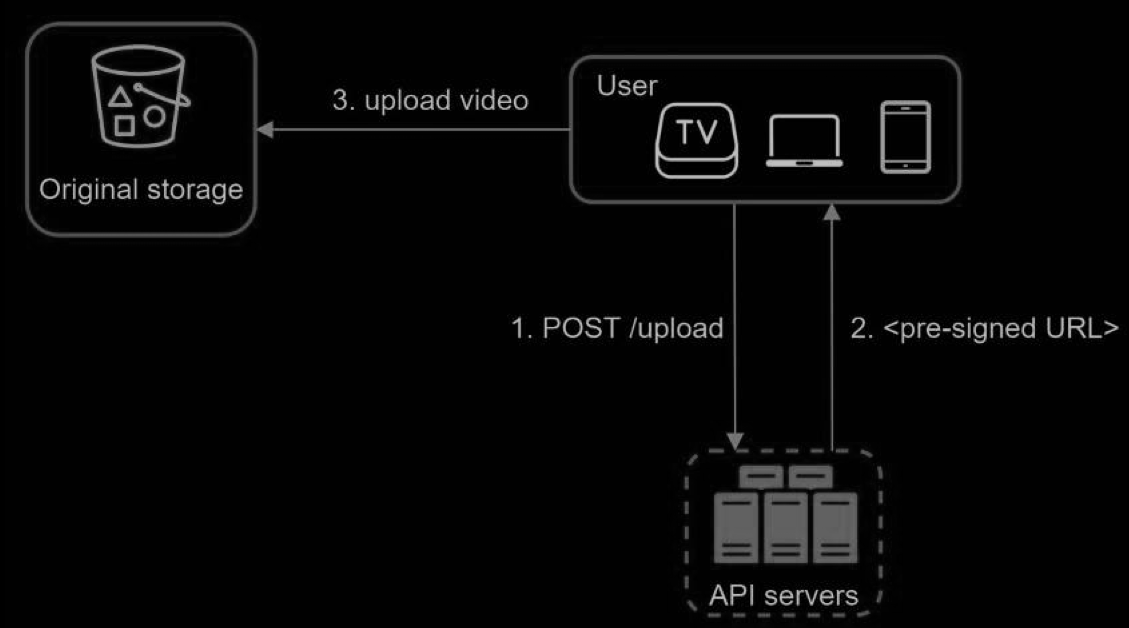
Safety optimization: protect your videos
Many content makers are reluctant to post videos online because they fear their original videos will be stolen. To protect copyrighted videos, we can adopt one of the following three safety options:
- Digital rights management (DRM) systems: Three major DRM systems are Apple FairPlay, Google Widevine, and Microsoft PlayReady.
- AES encryption: You can encrypt a video and configure an authorization policy. The encrypted video will be decrypted upon playback. This ensures that only authorized users can watch an encrypted video.
- Visual watermarking: This is an image overlay on top of your video that contains identifying information for your video. It can be your company logo or company name.
Cost-saving optimization
CDN is a crucial component of our system. It ensures fast video delivery on a global scale. However, from the back of the envelope calculation, we know CDN is expensive, especially when the data size is large. How can we reduce the cost?
Previous research shows that YouTube video streams follow long-tail distribution. It means a few popular videos are accessed frequently but many others have few or no viewers. Based on this observation, we implement a few optimizations:
- Only serve the most popular videos from CDN and other videos from our high capacity storage video servers
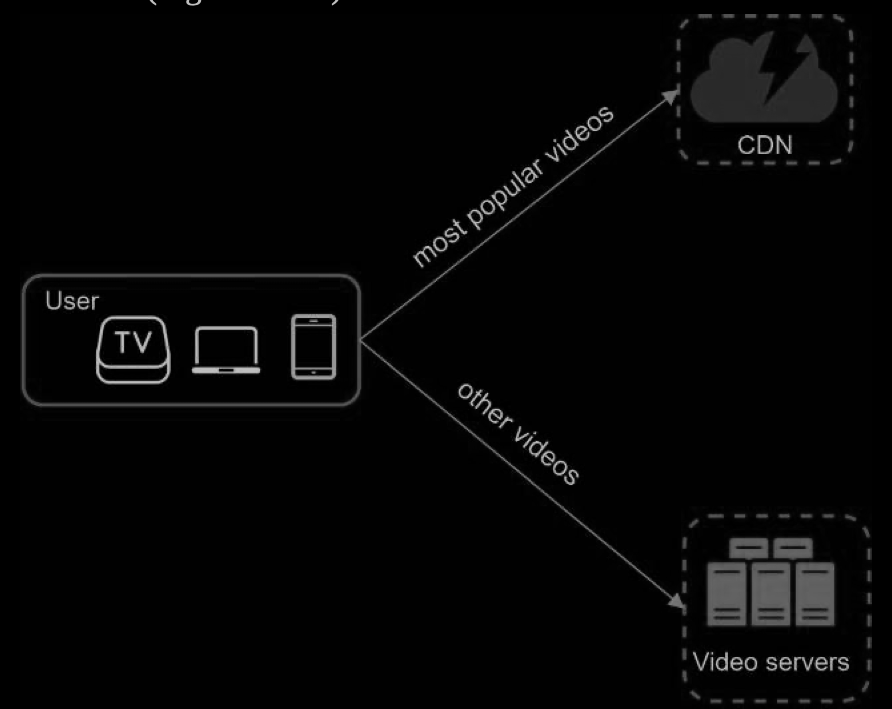
-
For less popular content, we may not need to store many encoded video versions. Short videos can be encoded on-demand.
-
Some videos are popular only in certain regions. There is no need to distribute these videos to other regions.
-
Build your own CDN like Netflix and partner with Internet Service Providers (ISPs). Building your CDN is a giant project; however, this could make sense for large streaming companies. An ISP can be Comcast, AT&T, Verizon, or other internet providers. ISPs are located all around the world and are close to users. By partnering with ISPs, you can improve the viewing experience and reduce the bandwidth charges.
Error handling
For a large-scale system, system errors are unavoidable. To build a highly fault-tolerant system, we must handle errors gracefully and recover from them fast. Two types of errors exist:
- Recoverable error. For recoverable errors such as video segment fails to transcode, the general idea is to retry the operation a few times. If the task continues to fail and the system believes it is not recoverable, it returns a proper error code to the client.
- Non-recoverable error. For non-recoverable errors such as malformed video format, the system stops the running tasks associated with the video and returns the proper error code to the client.
分布式文件存储系统
目前主流的分布式文件系统有:GFS、HDFS、Ceph、Lustre、MogileFS、MooseFS、FastDFS、TFS、GridFS等。
GFS(Google File System)
Google公司为了满足本公司需求而开发的基于Linux的专有分布式文件系统。尽管Google公布了该系统的一些技术细节,但Google并没有将该系统的软件部分作为开源软件发布。
HDFS(Hadoop Distributed File System)
HDFS(Hadoop Distributed File System)是 Hadoop 项目的一个子项目。是 Hadoop 的核心组件之一, Hadoop 非常适于存储大型数据 (比如 TB 和 PB),其就是使用 HDFS 作为存储系统. HDFS 使用多台计算机存储文件,并且提供统一的访问接口,像是访问一个普通文件系统一样使用分布式文件系统。
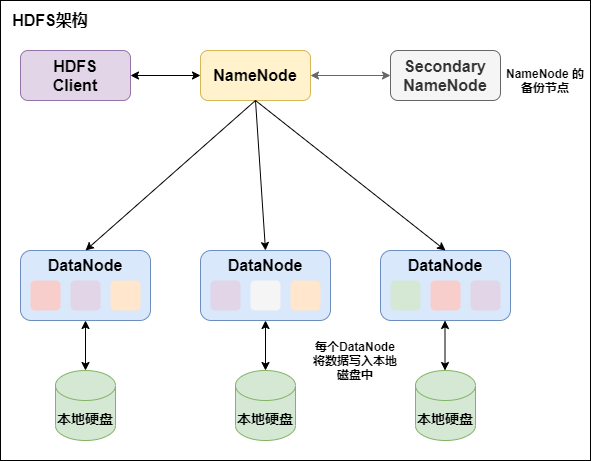
TFS(Taobao FileSystem)
TFS是一个高可扩展、高可用、高性能、面向互联网服务的分布式文件系统,主要针对海量的非结构化数据,它构筑在普通的Linux机器 集群上,可为外部提供高可靠和高并发的存储访问。TFS为淘宝提供海量小文件存储,通常文件大小不超过1M,满足了淘宝对小文件存储的需求,被广泛地应用在淘宝各项应用中。它采用了HA架构和平滑扩容,保证了整个文件系统的可用性和扩展性。同时扁平化的数据组织结构,可将文件名映射到文件的物理地址,简化 了文件的访问流程,一定程度上为TFS提供了良好的读写性能。
Reference
- System Design Interview – An insider’s guide
- Weibo video processing architecture (in Chinese): https://www.upyun.com/opentalk/399.html
- SVE: Distributed Video Processing at Facebook Scale: https://www.cs.princeton.edu/~wlloyd/papers/sve-sosp17.pdf
- YouTube scalability talk by early YouTube employee: https://www.youtube.com/watch? v=w5WVu624fY8